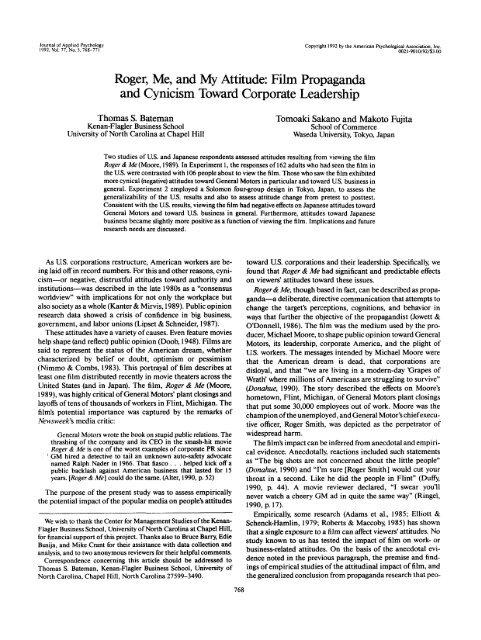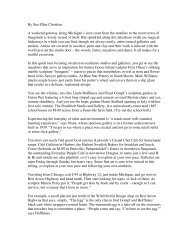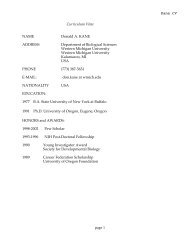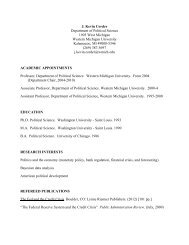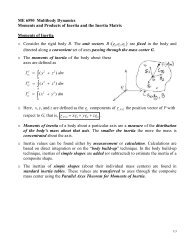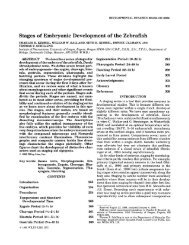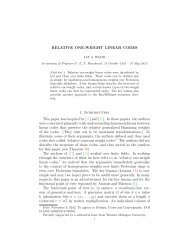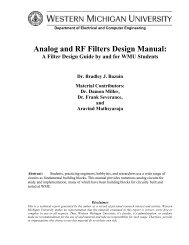Roger, Me, and My Attitude: Film Propaganda and Cynicism Toward ...
Roger, Me, and My Attitude: Film Propaganda and Cynicism Toward ...
Roger, Me, and My Attitude: Film Propaganda and Cynicism Toward ...
Create successful ePaper yourself
Turn your PDF publications into a flip-book with our unique Google optimized e-Paper software.
Journal of Applied Psychology<br />
1992, Vol. 77, No. 5, 768-771<br />
Copyright 1992 by the American Psychological Association, Inc.<br />
0021-9010/92/$3.00<br />
<strong>Roger</strong>, <strong>Me</strong>, <strong>and</strong> <strong>My</strong> <strong>Attitude</strong>: <strong>Film</strong> Propag<strong>and</strong>a<br />
<strong>and</strong> <strong>Cynicism</strong> <strong>Toward</strong> Corporate Leadership<br />
Thomas S. Bateman<br />
Kenan-Flagler Business School<br />
University of North Carolina at Chapel Hill<br />
Tomoaki Sakano <strong>and</strong> Makoto Fujita<br />
School of Commerce<br />
Waseda University, Tokyo, Japan<br />
Two studies of U.S. <strong>and</strong> Japanese respondents assessed attitudes resulting from viewing the film<br />
<strong>Roger</strong> & <strong>Me</strong> (Moore, 1989). In Experiment 1, the responses of 162 adults who had seen the film in<br />
the U.S. were contrasted with 106 people about to view the film. Those who saw the film exhibited<br />
more cynical (negative) attitudes toward General Motors in particular <strong>and</strong> toward U.S. business in<br />
general. Experiment 2 employed a Solomon four-group design in Tokyo, Japan, to assess the<br />
generalizability of the U.S. results <strong>and</strong> also to assess attitude change from pretest to posttest.<br />
Consistent with the U.S. results, viewing the film had negative effects on Japanese attitudes toward<br />
General Motors <strong>and</strong> toward U.S. business in general. Furthermore, attitudes toward Japanese<br />
business became slightly more positive as a function of viewing the film. Implications <strong>and</strong> future<br />
research needs are discussed.<br />
As U.S. corporations restructure, American workers are being<br />
laid off in record numbers. For this <strong>and</strong> other reasons, cynicism—or<br />
negative, distrustful attitudes toward authority <strong>and</strong><br />
institutions—was described in the late 1980s as a "consensus<br />
worldview" with implications for not only the workplace but<br />
also society as a whole (Kanter & Mirvis, 1989). Public opinion<br />
research data showed a crisis of confidence in big business,<br />
government, <strong>and</strong> labor unions (Upset & Schneider, 1987).<br />
These attitudes have a variety of causes. Even feature movies<br />
help shape (<strong>and</strong> reflect) public opinion (Doob, 1948). <strong>Film</strong>s are<br />
said to represent the status of the American dream, whether<br />
characterized by belief or doubt, optimism or pessimism<br />
(Nimmo & Combs, 1983). This portrayal of film describes at<br />
least one film distributed recently in movie theaters across the<br />
United States (<strong>and</strong> in Japan). The film, <strong>Roger</strong> & <strong>Me</strong> (Moore,<br />
1989), was highly critical of General Motors' plant closings <strong>and</strong><br />
layoffs of tens of thous<strong>and</strong>s of workers in Flint, Michigan. The<br />
film's potential importance was captured by the remarks of<br />
Newsweek's media critic:<br />
General Motors wrote the book on stupid public relations. The<br />
thrashing of the company <strong>and</strong> its CEO in the smash-hit movie<br />
<strong>Roger</strong> & <strong>Me</strong> is one of the worst examples of corporate PR since<br />
GM hired a detective to tail an unknown auto-safety advocate<br />
named Ralph Nader in 1966. That fiasco . . . helped kick off a<br />
public backlash against American business that lasted for IS<br />
years. [<strong>Roger</strong> & <strong>Me</strong>] could do the same. (Alter, 1990, p. 52)<br />
!<br />
The purpose of the present study was to assess empirically<br />
the potential impact of the popular media on people's attitudes<br />
We wish to thank the Center for Management Studies of the Kenan-<br />
Flagler Business School, University of North Carolina at Chapel Hill,<br />
for financial support of this project. Thanks also to Bruce Barry, Edie<br />
Busija, <strong>and</strong> Mike Grant for their assistance with data collection <strong>and</strong><br />
analysis, <strong>and</strong> to two anonymous reviewers for their helpful comments.<br />
Correspondence concerning this article should be addressed to<br />
Thomas S. Bateman, Kenan-Flagler Business School, University of<br />
North Carolina, Chapel Hill, North Carolina 27599-3490.<br />
768<br />
toward U.S. corporations <strong>and</strong> their leadership. Specifically, we<br />
found that <strong>Roger</strong> & <strong>Me</strong> had significant <strong>and</strong> predictable effects<br />
on viewers' attitudes toward these issues.<br />
<strong>Roger</strong> & <strong>Me</strong>, though based in fact, can be described as propag<strong>and</strong>a—a<br />
deliberate, directive communication that attempts to<br />
change the target's perceptions, cognitions, <strong>and</strong> behavior in<br />
ways that further the objective of the propag<strong>and</strong>ist (Jowett &<br />
O'Donnell, 1986). The film was the medium used by the producer,<br />
Michael Moore, to shape public opinion toward General<br />
Motors, its leadership, corporate America, <strong>and</strong> the plight of<br />
U.S. workers. The messages intended by Michael Moore were<br />
that the American dream is dead, that corporations are<br />
disloyal, <strong>and</strong> that "we are living in a modern-day 'Grapes of<br />
Wrath' where millions of Americans are struggling to survive"<br />
(Donahue, 1990). The story described the effects on Moore's<br />
hometown, Flint, Michigan, of General Motors plant closings<br />
that put some 30,000 employees out of work. Moore was the<br />
champion of the unemployed, <strong>and</strong> General Motor's chief executive<br />
officer, <strong>Roger</strong> Smith, was depicted as the perpetrator of<br />
widespread harm.<br />
The film's impact can be inferred from anecdotal <strong>and</strong> empirical<br />
evidence. Anecdotally, reactions included such statements<br />
as "The big shots are not concerned about the little people"<br />
(Donahue, 1990) <strong>and</strong> "I'm sure [<strong>Roger</strong> Smith] would cut your<br />
throat in a second. Like he did the people in Flint" (Duffy,<br />
1990, p. 44). A movie reviewer declared, "I swear you'll<br />
never watch a cheery GM ad in quite the same way" (Ringel,<br />
1990, p. 17).<br />
Empirically, some research (Adams et al., 1985; Elliott &<br />
Schenck-Hamlin, 1979; Roberts & Maccoby, 1985) has shown<br />
that a single exposure to a film can affect viewers' attitudes. No<br />
study known to us has tested the impact of film on work- or<br />
business-related attitudes. On the basis of the anecdotal evidence<br />
noted in the previous paragraph, the premise <strong>and</strong> findings<br />
of empirical studies of the attitudinal impact of film, <strong>and</strong><br />
the generalized conclusion from propag<strong>and</strong>a research that peo-
ROGER & ME 769<br />
pie respond favorably to a message even when it is obvious that<br />
it is biased (Jowett & O'Donnell, 1986), we predicted that <strong>Roger</strong><br />
& <strong>Me</strong> would have a direct effect on audience attitudes toward<br />
the targets criticized in the film, in a direction consistent with<br />
that intended by the producer. That is, people who had seen the<br />
film were expected to express more cynical (negative) attitudes<br />
toward <strong>Roger</strong> Smith <strong>and</strong> General Motors than were people who<br />
had not viewed the film.<br />
Although the explicit targets of Michael Moore's attacks were<br />
<strong>Roger</strong> Smith <strong>and</strong> his corporation, the ultimate "villain" was big<br />
business (Duffy, 1990). Thus, we anticipated that audience reactions<br />
would generalize beyond General Motors. This prediction<br />
follows not only from Michael Moore's objectives but also<br />
from prominent theories of attitude structure <strong>and</strong> cognitive inference.<br />
<strong>Attitude</strong>s have a certain degree of consistency with one<br />
another, as known from decades of theorizing <strong>and</strong> research in<br />
cognitive consistency (Festinger, 1957; Heider, 1958; cf. Judd &<br />
Krosnick, 1988). Moreover, people are readily influenced in<br />
their attitudes toward populations by information from a single<br />
case (Hamill, Wilson, & Nisbett, 1980; Nisbett & Ross, 1980).<br />
Given that General Motors is a single case in the population of<br />
major U.S. corporations, <strong>and</strong> that it is vividly <strong>and</strong> negatively<br />
portrayed in <strong>Roger</strong> & <strong>Me</strong>, cognitive consistency theory <strong>and</strong> sample-to-population<br />
inferential biases led to the prediction that<br />
<strong>Roger</strong> & <strong>Me</strong> would affect audience attitudes toward U.S. business<br />
in general. People who viewed the film, compared with<br />
those who had not yet viewed the film, were predicted to express<br />
more cynical (negative) attitudes toward U.S. corporations<br />
<strong>and</strong> their leadership.<br />
<strong>Me</strong>thod<br />
Experiment 1<br />
Sample <strong>and</strong> procedure. The sample consisted of 268 adults who<br />
attended a movie theater in Durham, North Carolina, for the purpose<br />
of viewing <strong>Roger</strong> & <strong>Me</strong>. The average age of the study sample was 36, <strong>and</strong><br />
49% of the respondents were male.<br />
A graduate assistant distributed <strong>and</strong> collected questionnaires in the<br />
theater lobby, with the permission of the theater manager. Over a 2-<br />
week time period, beginning immediately after the film's release,<br />
theater patrons were solicited both as they entered <strong>and</strong> exited the<br />
theater in which the film appeared. This resulted in two subsamples of<br />
volunteer respondents: one that had not yet viewed the film (« = 106)<br />
<strong>and</strong> one that had (« = 162). Thus, the study design contrasted a pretest<br />
group with a posttest group. The two groups did not differ significantly<br />
with respect to age, gender, tendency to sympathize with labor<br />
versus management (as measured by a single item in the survey), or<br />
interest in the film <strong>and</strong> the subject matter (as inferred from the fact that<br />
all respondents had purchased tickets for <strong>Roger</strong> & <strong>Me</strong>). This comparability<br />
established the viability of using pretest scores as control group<br />
data against which to compare posttest attitudes of the experimental<br />
group.<br />
<strong>Me</strong>asures. Respondents completed a written survey. The instructions<br />
introduced the nature of the study <strong>and</strong> conveyed the anonymity<br />
<strong>and</strong> confidentiality of the results. Care was taken to encourage complete<br />
honesty in responding, to indicate that there were no right or<br />
wrong answers, <strong>and</strong> to imply a lack of bias, preconception, or social or<br />
political agenda on the part of the researchers.<br />
The survey was constructed to assess two dependent measures: attitude<br />
toward General Motors, <strong>and</strong> general cynicism toward U.S. business<br />
<strong>and</strong> its leadership. The General Motors measure consisted of two<br />
7-point Likert items asking respondents to indicate their general opinions<br />
of General Motors <strong>and</strong> of <strong>Roger</strong> Smith. The cynicism measure<br />
consisted of nine 7-f>oint items, to which respondents indicated the<br />
extent of their agreement or disagreement. To reduce the negative connotation<br />
<strong>and</strong> inflammatory potential of cynical phrases in the survey,<br />
most of the items were phrased in a positive rather than negative direction.<br />
Examples are "Most of our top business leaders are devoted to the<br />
service <strong>and</strong> good of their employees" "I have great respect for the<br />
major corporations of our country," <strong>and</strong> "The American dream, in<br />
which anyone can work hard <strong>and</strong> get ahead, is alive <strong>and</strong> well." Lower<br />
scores on this scale indicate more negative attitudes <strong>and</strong> higher levels<br />
of cynicism.<br />
Results <strong>and</strong> Discussion<br />
The two-item General Motors variable had internal reliabilities<br />
of .83 (r = .70) in the pretest group <strong>and</strong> .80 (r = .67) in the<br />
posttest group. The cynicism measure had internal reliabilities<br />
of .75 <strong>and</strong> .82 in the two groups.<br />
The two dependent variables were significantly correlated<br />
(r = .48, p < .001). We conducted two separate univariate analyses<br />
of variance, which was appropriate given our independent<br />
interest in the two variables <strong>and</strong> our cognizance of the implications<br />
of multiple tests (Huberty & Morris, 1989). People who<br />
had seen the film exhibited a more negative attitude toward<br />
General Motors (M = 3.8, SD = 2.3) than people who had not<br />
seen the film (M = 6.15, SD = 2.8), F(l, 246) = 51.40, p < .001.<br />
Those who had seen the film also reported greater cynicism or<br />
negative attitudes toward U.S. business in general (M = 23A,<br />
SD = 8.8) than did those who had not seen the film (M= 26.9,<br />
SD = 8.3), F(l, 260) = 9.95, p < .05. Thus, the results support<br />
the predictions that viewing <strong>Roger</strong> & <strong>Me</strong> would affect audience<br />
attitudes in directions intended by the film's producer.<br />
Because of practical constraints on the study design, limitations<br />
temper the strength of the conclusions regarding the impact<br />
of the film. Demonstrable attitude change—coupled with<br />
no change in a pre-post control group—would be the most<br />
compelling evidence of the film's impact. Therefore, a second<br />
study was conducted. This study differed from the first in that<br />
we added measures of attitude change <strong>and</strong> an appropriate control<br />
group. In addition, the study measured the film's impact on<br />
a sample of moviegoers in a different country.<br />
Experiment 2<br />
In the summer of 1990, Warner Brothers released a subtitled<br />
version of <strong>Roger</strong> & <strong>Me</strong> (Moore, 1989) in Japan. Experiment 2<br />
offered methodological advances over the first experiment <strong>and</strong><br />
served to test the generalizability of the U.S. results as well as to<br />
assess attitudes toward Japanese business. We predicted a replication<br />
(with extension to pretest-posttest attitude change) of<br />
the results of Experiment 1: People were expected to express<br />
more negative attitudes toward General Motors <strong>and</strong> U.S. business<br />
after viewing the film, compared with their own pre-viewing<br />
attitudes <strong>and</strong> with the attitudes of respondents who had not<br />
viewed the film.<br />
Moreover, we predicted that the film would lead the audience<br />
to perceive Japanese business more positively. Given the<br />
Japanese philosophy that workers <strong>and</strong> their firms share the<br />
same fate, viewing the negative consequences of the layoffs im-
770 T. BATEMAN, T. SAKANO, AND M. FUJITA<br />
posed by American executives on their employees was expected<br />
to provide a st<strong>and</strong>ard of comparison by which Japanese company<br />
policies would look all the more fair <strong>and</strong> honorable.<br />
Through processes of social comparison (Kelley & Thibaut,<br />
1978) <strong>and</strong> pressures toward cognitive consistency (Judd &<br />
Krosnick, 1988), we predicted that people would express more<br />
positive attitudes toward Japanese business after viewing the<br />
film, when compared with their own pre-viewing attitudes <strong>and</strong><br />
with the attitudes of people who had not viewed the film.<br />
<strong>Me</strong>thod<br />
Sample <strong>and</strong> procedure. The sample consisted of 542 university<br />
students in Tokyo, Japan. The average age of the sample was 20.8 years,<br />
<strong>and</strong> 87.6% of the sample was male. Twelve sections of a management<br />
course required of all commerce students were r<strong>and</strong>omly assigned to<br />
four experimental conditions in a Solomon four-group design. Two of<br />
the groups completed a questionnaire in class before <strong>Roger</strong> & <strong>Me</strong> was<br />
released in Japan. Approximately half of the students who completed<br />
the survey, <strong>and</strong> half who did not, then viewed <strong>Roger</strong> & <strong>Me</strong> in a local<br />
theater. Subsequently, all students completed the same questionnaire.<br />
Thus, two groups replicated Study 1: Group 1 (« = 132) saw the film <strong>and</strong><br />
completed a posttest (without a pretest), <strong>and</strong> Group 2 (n = 144) was a<br />
control group that completed a posttest concomitantly with Group 1<br />
but without having viewed the film. Two other groups were added to<br />
the Study 1 design: Group 3 (n = 137) was an experimental group that<br />
completed a pretest, saw the film, <strong>and</strong> then completed a posttest, <strong>and</strong><br />
Group 4 (n = 129) was a control group that completed two surveys<br />
concomitantly with Group 3 but did not view the film.<br />
<strong>Me</strong>asures. Survey items from Experiment 1 were translated into<br />
Japanese for use in Experiment 2. The Experiment 2 questionnaire<br />
also measured a third dependent variable not used in Experiment 1.<br />
This scale adapted Experiment 1 items to assess attitudes toward Japanese<br />
business <strong>and</strong> its leaders. Six of the nine items of the cynicism<br />
scale—excluding items that were presumed to be too difficult for the<br />
average Japanese to validly express an attitude toward (prior to seeing<br />
the film)—were reworded with a Japanese rather than U.S. business<br />
referent.<br />
Results <strong>and</strong> Discussion<br />
The General Motors measure had a coefficient alpha of .64<br />
(r = .48) in the pretest-only groups <strong>and</strong> .82 (r = .69) in the<br />
posttest-only groups. The scale measuring cynicism toward<br />
U.S. business showed reliabilities of .64 (pretest-only groups)<br />
<strong>and</strong> .73 (posttest-only groups). The measure of attitudes toward<br />
Japanese business had a coefficient alpha of .78 in both the<br />
pretest <strong>and</strong> posttest samples.<br />
Consistent with the recommendations of Solomon (1954),<br />
we conducted a two-way analysis of variance, using Time 2<br />
measures as dependent variables. The independent variables<br />
were whether or not subjects had (a) seen the film <strong>and</strong> (b) taken<br />
a pretest. Results revealed significant effects of film viewing on<br />
all dependent variables. As in Study 1, the group that had seen<br />
the film had more negative attitudes toward General Motors<br />
(M= 3.75, SD = 1.9) than did the group that had not (M = 5.5,<br />
SD = 2.75), F(\, 538) = 130.39, p < .001. Those who saw the<br />
film also held more cynical (negative) attitudes toward U.S. business<br />
(M = 28.8, SD = 7.2) than those who had not (M = 33.8,<br />
SD = 5.9), F(\, 533) = 76.42, p < .001. In addition, the group<br />
that saw the film reported slightly more positive attitudes toward<br />
Japanese business (M = 22.3, SD = 5.2) than the group<br />
that did not (M= 20.7, SD = 5.6), F(\, 535) = 12.32, p < .05.<br />
Analysis of the posttest scores further revealed that the pretest,<br />
either as a main effect or in interaction with film viewing,<br />
had no significant effect on general attitudes toward either U.S.<br />
or Japanese business. There was a main effect of the pretest on<br />
attitudes toward General Motors, F(\, 538) = 3.94, p < .05, <strong>and</strong><br />
an interaction effect as well, F(l, 538) = 6.29, p < .05. The<br />
significant main effect stemmed from the interaction, in which<br />
posttest scores for subjects who did not see the film were comparable<br />
to the scores of those who did (M= 7.6, SD = 1.8) <strong>and</strong> did<br />
not (M= 7.5, SD = 2.0) complete the pretest, whereas filmgoers<br />
who completed the pretest had more negative attitudes (M =<br />
5.1, SD = 2.2) than filmgoers who did not (M = 5.9, SD = 2.2).<br />
Separate analyses were performed on the treatment <strong>and</strong> control<br />
groups that provided measures of attitude change (Groups<br />
3 <strong>and</strong> 4). <strong>Me</strong>ans for pretest <strong>and</strong> posttest scores for the three<br />
dependent variables, in the treatment <strong>and</strong> control groups, are<br />
shown in Table 1. Paired (correlated) t tests showed that the<br />
changes in the group that viewed the film were highly significant<br />
for all variables. In contrast, the control group did not<br />
change attitudes toward General Motors or U.S. business; the<br />
change in attitude toward Japanese business was significant but<br />
quite small.<br />
General Discussion<br />
<strong>Roger</strong> & <strong>Me</strong> was described by a leading critic (Gene Siskel) as<br />
one of the two films that most epitomize the Reagan era<br />
(Moore, 1990). As such, it was an important film release, one<br />
intended to shape public opinion in the United States. <strong>Roger</strong> &<br />
<strong>Me</strong> had an impact on Japanese audiences as well. Taken to-<br />
Table 1<br />
<strong>Me</strong>ans, St<strong>and</strong>ard Deviations, <strong>and</strong> Paired t Tests for Changes in Dependent Variables<br />
Treatment group<br />
Control group<br />
Dependent<br />
variable<br />
M<br />
Pretest<br />
SD<br />
M<br />
Posttest<br />
SD<br />
1(136)<br />
M<br />
Pretest<br />
SD<br />
M<br />
Postest<br />
SD<br />
t(128)<br />
<strong>Attitude</strong> toward General Motors<br />
<strong>Attitude</strong> toward U.S. business<br />
<strong>Attitude</strong> toward Japanese business<br />
3.92<br />
3.87<br />
3.38<br />
0.83<br />
0.76<br />
0.86<br />
2.56<br />
3.16<br />
3.77<br />
1.11<br />
0.85<br />
0.86<br />
12.39**<br />
8.64**<br />
-5.73**<br />
3.71<br />
3.80<br />
3.33<br />
0.91<br />
0.63<br />
0.92<br />
3.80<br />
3.77<br />
3.44<br />
0.92<br />
0.60<br />
0.93<br />
-1.55<br />
0.42<br />
-2.52*<br />
*/>
ROGER & ME 771<br />
gether, the two studies revealed (a) significant negative effects of<br />
the film on U.S. audiences' attitudes toward General Motors<br />
<strong>and</strong> US. business in general; (b) similar effects on Japanese<br />
audiences' attitudes toward General Motors <strong>and</strong> U.S. business;<br />
(c) a significant positive impact on Japanese attitudes toward<br />
Japanese business; <strong>and</strong> (d) attitude change, in directions consistent<br />
with the other findings, in the Japanese audience. Thus,<br />
the presumed potential of the popular media to influence audience<br />
attitudes toward business has been empirically demonstrated.<br />
Longer term effects, both attitudinal <strong>and</strong> behavioral, should<br />
be the focus of future research. Theoretically, the essential issue<br />
with regard to both long-term attitude <strong>and</strong> behavioral change<br />
may be how the message is processed. Enduring attitude<br />
change, <strong>and</strong> attitudes that are most strongly predictive of corresponding<br />
behaviors, are more likely to occur through central<br />
rather than peripheral information processing (Petty & Cacioppo,<br />
1986). A central route implies active processing in<br />
which the person consciously thinks about the issue; the central<br />
route is activated when the audience is motivated <strong>and</strong> able to<br />
process the information. Specific pertinent conditions include<br />
repetition <strong>and</strong> comprehensibility of the message, lack of distraction,<br />
<strong>and</strong> audience involvement (Petty & Cacioppo, 1986). It<br />
is likely that most if not all of these conditions were met in the<br />
present study by the self-selection of participants <strong>and</strong> the viewing<br />
of a vivid, 2-hr film in a closed environment. For the Japanese<br />
sample, completion of the pretest may have enhanced this<br />
effect.<br />
How corporations <strong>and</strong> their leaders respond to media criticism,<br />
<strong>and</strong> the effectiveness of different responses in influencing<br />
the perceptions <strong>and</strong> behaviors of various stakeholder<br />
groups, are related areas ripe for future study. Ultimately, a key<br />
question is whether public opinion toward corporations, as<br />
shaped by the media, carries any practical import. In Japan, a<br />
film reviewer used <strong>Roger</strong> & <strong>Me</strong> as a warning to his country: "If<br />
we cannot make the cars which fit the customers' needs, Japan<br />
will follow the same destiny [as General Motors]" (Hirai, 1990,<br />
p. 44). In the United States, General Motors suffered some bad<br />
publicity at the least. Moreover, the success of <strong>Roger</strong> & <strong>Me</strong> <strong>and</strong><br />
the kudos afforded its producer may pave the way for more<br />
feature films with an antibusiness agenda. To the extent that<br />
the media are successful at sustaining or increasing cynicism<br />
among workers <strong>and</strong> other stakeholders, the cumulative impact<br />
could be substantial (Kanter & Mirvis, 1989). Therefore, future<br />
research should continue to assess the impact of the media on<br />
cynicism, other attitudes, <strong>and</strong> behaviors toward U.S. business<br />
<strong>and</strong> its leadership.<br />
References<br />
Adams, W, Salzman, A., Vantine, W, Suelter, L., Baker, A., Bonvouloir,<br />
L., Brenner, B., Ely, M, Feldman, J, & Ziegel, R. (1985). The power<br />
of The Right Stuff: A quasi-experimental field test of the docudrama<br />
hypothesis. Public Opinion Quarterly, 49, 330-339.<br />
Alter, J. (1990, April). Who framed <strong>Roger</strong> Smith? Blame it on General<br />
Motors. Business Month, p. 52.<br />
Donahue (1990, January 29). On location in Flint, Michigan: <strong>Film</strong>maker<br />
Michael Moore, <strong>Roger</strong> & <strong>Me</strong>. Part 1. (Patricia McMillen, Producer;<br />
Transcript 2870, Show 0192-90.) (Journal Graphics, New<br />
York).<br />
Doob, L. W (1948). Public opinion <strong>and</strong> propag<strong>and</strong>a. New York: Holt.<br />
Duffy, S. (1990, January 8). The real villain in <strong>Roger</strong> & <strong>Me</strong>l Big business.<br />
Newsweek, pp. 42, 44.<br />
Elliott, W, & Schenck-Hamlin, W (1979). <strong>Film</strong>, politics, <strong>and</strong> the press:<br />
The influence of All the President's <strong>Me</strong>n. Journalism Quarterly, 56,<br />
546-553.<br />
Festinger, L. (1957). A theory of cognitive dissonance. Stanford, CA:<br />
Stanford University Press.<br />
Hamill, R., Wilson, T, & Nisbett, R. (1980). Insensitivity to sample<br />
bias: Generalizing from atypical cases. Journal of Personality <strong>and</strong><br />
Social Psychology, 39, 578-589.<br />
Heider, F. (1958). The psychology of interpersonal relations. New \brk:<br />
Wiley.<br />
Hirai, T. (1990, June 26). "<strong>Roger</strong> & <strong>Me</strong>": The correct way of viewing the<br />
movie using GM chairman as a model. Asahi Shimbun Weekly AR-<br />
ERA, p. 70.<br />
Huberty, C, & Morris, J. (1989). Multivariate analysis versus multiple<br />
univariate analyses. Psychological Bulletin, 105, 302-308.<br />
Jowett, G, & O'Donnell, D. (1986). Propag<strong>and</strong>a <strong>and</strong> persuasion. Newbury<br />
Park, CA: Sage.<br />
Judd, C, & Krosnick, J. (1988). The structural basis of consistency<br />
among political attitudes. In A. Pratkanis, S. Breckler, & A. Greenwald<br />
(Eds.), <strong>Attitude</strong> structure <strong>and</strong> function (pp. 99-128). Hillsdale,<br />
NJ: Erlbaum.<br />
Kanter, D., & Mirvis, P. (1989). The cynical Americans. San Francisco:<br />
Jossey-Bass.<br />
Kelley, H., & Thibaut, J. (1978). Interpersonal relations: A theory of<br />
interdependence. New York: Wiley.<br />
Lipset, S., & Schneider, W (1987). The confidence gap. Baltimore, MD:<br />
Johns Hopkins University Press.<br />
Moore, M. (Producer & Director). (1989). <strong>Roger</strong> & <strong>Me</strong> [<strong>Film</strong>]. Burbank,<br />
CA: Warner Brothers.<br />
Moore, M. (1990, July 15). "<strong>Roger</strong>" <strong>and</strong> I, off to Hollywood <strong>and</strong> home<br />
to Flint. New York Times, pp. HI, H12.<br />
Nimmo, D., & Combs, J. (1983). <strong>Me</strong>diated political realities. New York:<br />
Longman.<br />
Nisbett, R., & Ross, L. (1980). Human inference: Strategies <strong>and</strong> shortcomings<br />
of social judgment. Englewood Cliffs, NJ: Prentice-Hall.<br />
Petty, R., & Cacioppo, J. (1986). The elaboration likelihood model of<br />
persuasion. In L. Berkowitz (Ed.), Advances in experimental social<br />
psychology (Vol. 19, pp. 123-205). San Diego, CA: Academic Press.<br />
Ringel, E. (1990, March 2). Nightmare version of It's a Wonderful Life.<br />
Durham Morning Herald, Preview, pp. 17-18.<br />
Roberts, D, & Maccoby, N. (1985). Effects of mass communication. In<br />
G. Lindzey & E. Aronson (Eds.), The h<strong>and</strong>book of social psychology<br />
(3rd ed., Vol. 2, 539-598). New York: R<strong>and</strong>om House.<br />
Solomon, R. (1954). An extension of control group design. American<br />
Journal of Psychology, 67, 573-589.<br />
Received May 13,1991<br />
Revision received April 17,1992<br />
Accepted April 17,1992 •


